Travel around the bustling market to collect the best goods before your opponent does – plan your moves, sell the best sets of goods, and avoid corruption to gain the favor of Sobek and become the greatest merchant in all of Egypt!
What Is Sobek: 2 Players?
Sobek: 2 Players is a family-weight set collection game for 2 players only, ages 10 and up, that takes about 20 minutes to play. The base game retails for $29.95 and is available on the Pandasaurus Games website as well as your local game store! This game features of a surprising depth of strategy but the ruleset and mechanics are fairly straightforward so feel free to take the age recommendation with a grain of salt.
Sobek: 2 Players was designed by Bruno Cathala and Sébastien Pauchon, with art from Naïade, and was published by Pandasaurus Games.
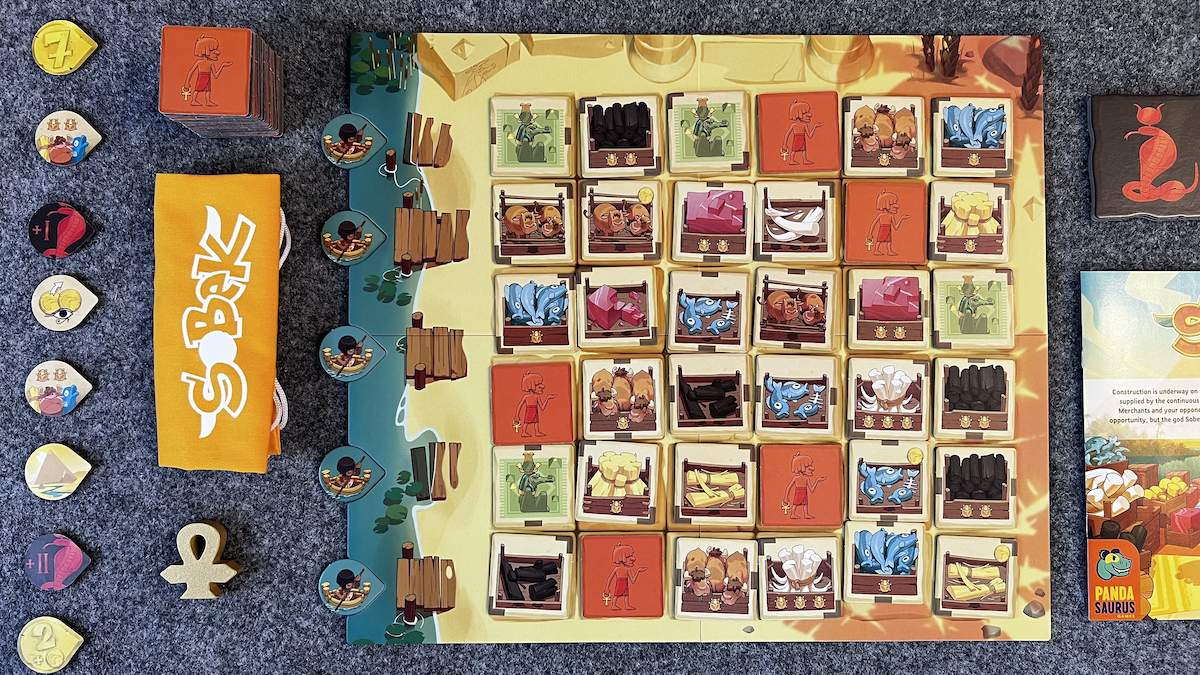
Sobek: 2 Players Components
- 1 large Market Board
- 10 Starting Tiles (grey back)
- 45 Goods Tiles (black back)
- 10 Character Tiles (red back)
- 13 Pirogue Tokens
- 1 Deben Bag
- 13 Deben Tokens
- 2 Corruption Boards
- 1 Ankh Pawn
- 2 Player Aids
- 2 Score Tokens

The Market Board has three distinct visual tiers on it marked by a hieroglyph and an arrow in the top left corner. This is a reminder for how to refill the market when it needs to be replenished in the game – starting from the center and moving out from there. My only comment is that sometimes when collecting tiles in the middle of the Market Board, clumsy hands can cause the whole market to shift – the game would have definitely benefited from a recessed board of some sort but due to rising production costs, I can understand the omission.
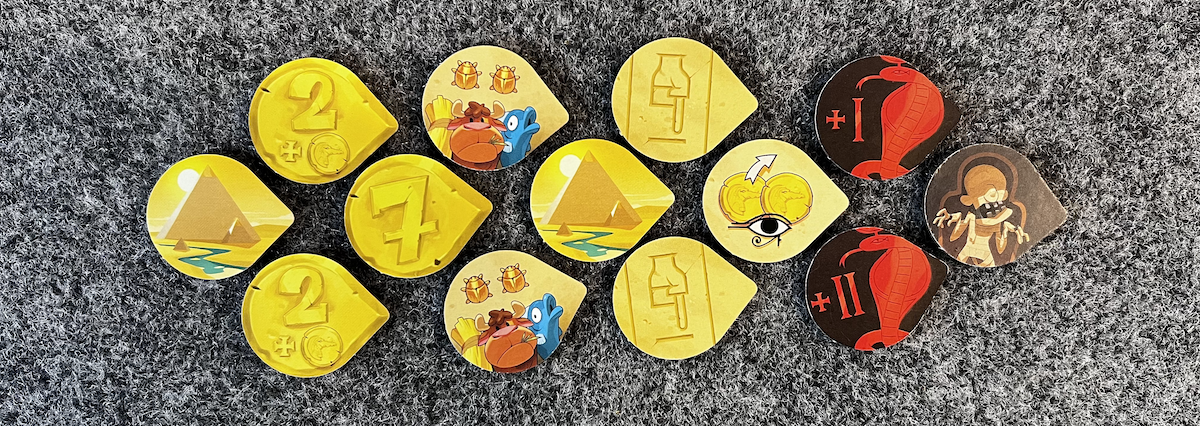
The Pirogue Tokens add an interesting wrinkle to the gameplay as only 5 out of the 13 will be available during the game. These tokens can give you bonuses like an extra turn or a free Deben, but they can also mess with your opponent by giving them corruption, so make sure to collect them before they’re gone!

The Debens are another interesting element as they represent a high risk, high reward strategy to get some big points. The Deben Tokens are valued from 3 to 9 points, with the distribution skewing towards the lower values, but if you’re able draw some of the higher Debens from the bag, they can make a big difference at the end of the game.
Overall, the production is simple, elegant, and not overdone, which in this day and age is hard to come by. The art is both engaging and informative, although the printing seems to be a bit washed out on the Goods Tiles. The box size is appropriate with minimal wasted space – all in all, it’s a solid start. But how does it play?
How to Play Sobek: 2 Players
You can download a copy of the rulebook here.
The Goal
The goal of Sobek: 2 Players is to be the merchant with the most total points when there are no viable moves remaining, both on the board and in your hand – you’ll gain points from all of your scored sets of goods and Deben Tokens you’ve collected and whoever has the most points wins!
Setup
Shuffle the 10 Starting Tiles with light grey backs, and deal 2 to each player. Then, place the Market Board in the center of the table and reveal 4 more of the Starting Tiles to be placed face up on the 4 center spaces. The remaining 2 Starting Tiles will be returned to the box.

Shuffle the Goods Tiles (black backs) and the Character Tiles (red backs) together and consolidate them into a single facedown pile. Then draw tiles from that pile to fill the market, starting in the top left of the second tier and placing clockwise, filling that entire ring before moving onto the third outer tier. Each Goods Tile will be placed face up on the Market Board while each Character Tile should remain face down.
Shuffle the 13 Pirogue Tokens and place 5 of them face down in the slots on the left side of the Market Board. Leave the remaining Pirogue Tokens within reach. Take the 13 Deben Tokens, drop them in the bag, and give it a shake to mix them all up, making sure to put all the good ones on top!
Each player will now take a Corruption Board and make sure they can access the two player aids which contain valuable information. Then randomly choose a first player (I like to give it to the last person who has listened to “Walk Like an Egyptian” by The Bangles) and give them the Ankh Pawn. Now you’re ready to start!
Gameplay
On your turn, you can do one of these three actions: you can either take a tile from the Market Board, sell a set of Goods Tiles from your hand, or play a Character Tile from your hand to activate its ability. Taking Goods Tiles will make up the majority of your actions so let’s talk about that one first.

When you’re taking a tile from the Market Board, the most important thing to pay attention to is the orientation of the Ankh Pawn. Whenever a new tile is selected, starting from the first turn onward, the Ankh Pawn will be oriented in a direction based on the markings on the tile that was taken. This is an important concept to grasp as it will inform your decisions about what tiles to take based on what tiles you’ll be making available to your opponent.
Once you’ve confirmed the orientation, you may collect any Goods or Character Tile in the row, column, or diagonal determined by the Ankh Pawn. You may choose to skip over any tiles on the way to your selection but you’ll have to place those skipped tiles on your Corruption Board which can prevent you from getting bonuses at end of the game. The single tile that you choose to collect will be added to your hand and the Ankh Pawn will be re-oriented accordingly.

If you choose to collect a face down Character Tile, you may notice that there are no Ankh orientation markings on these. That’s because when you pick one of these tiles, you can immediately orient the Ankh Pawn in the direction of your choosing! This is super useful for trying to control your opponent’s market selection or planning your own moves in advance.
If at any point, you would like to take a tile from the Market Board, but there are no tiles available in the row, column, or diagonal you’re selecting from, then you can instead choose to refill the market. Remove the Ankh Pawn from the board and use the stack of Goods and Character Tiles to replenish the Market Board, starting from the center and working outwards. You will continue placing tiles until either the Market Board is full again or the stack runs out. Then you’ll take the Ankh Pawn and place it on one of the four central squares, collecting the tile there, and orienting the pawn accordingly. If you want to refill the market but the stack of tiles is empty, you cannot take this action.

So what can you do if you don’t want to collect a tile? Well, the first course of action would be to sell a set of tiles from your hand. To sell a set, you must place at least 3 tiles of the same type, face up in front of you. You don’t have to use all of the tiles of that type in your hand, but generally, the bigger the set, the more points you’ll score at the end of the game. You can also include Character Tiles and green Sobek Statues (which act as wilds) in your set.
When you sell a set, you’ll score points based on the amount of scarab icons present multiplied by the number of tiles in the set, but don’t worry if you only have a small set to begin with – set values will only be added up at the end of the game! You can keep adding onto a set of goods throughout the game if you collect the right tiles, which can help you increase your multipliers and boost your final score.
Also when you sell a set, you’ll get to look at all of the remaining Pirogue Tokens, collect one, and activate its ability immediately! These bonuses can make your sets more valuable, add Corruption to your opponent’s board, or even give you an extra turn, so make sure you snatch these up before they’re all gone!
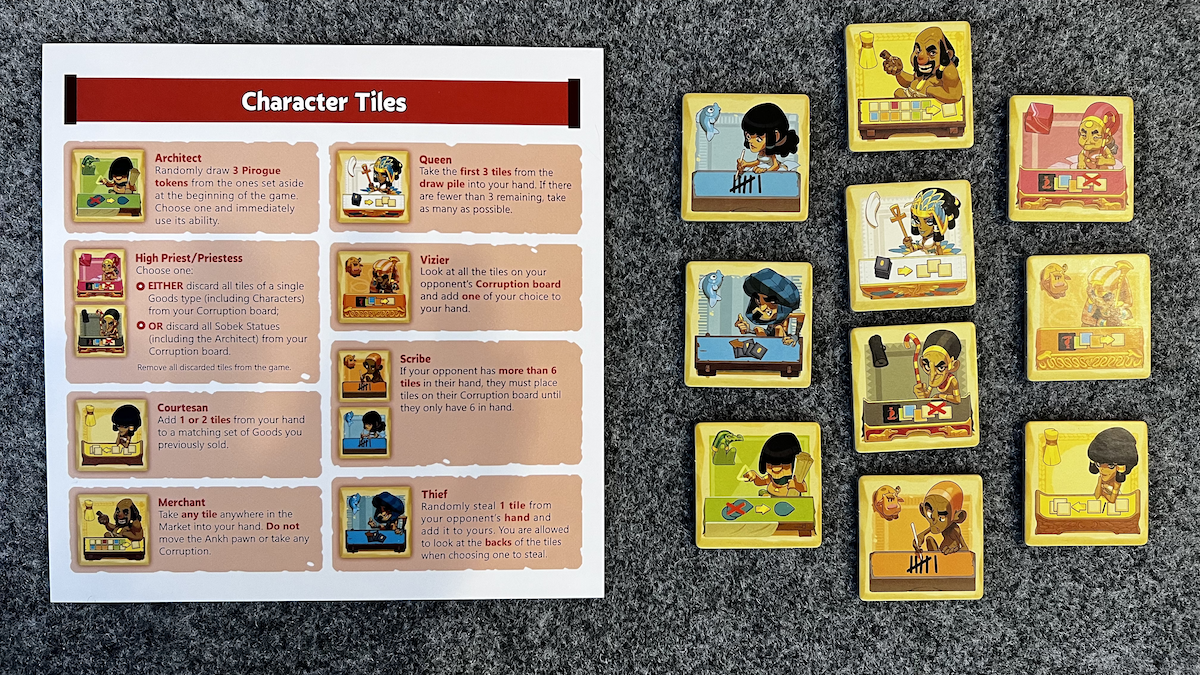
Finally, instead of taking a tile or selling a set, you can choose to play a Character Tile from your hand and activate its ability. The abilities are explained in detail on the Player Aid but generally they’ll allow you to do some really cool actions like remove tiles from your Corruption Board or steal a tile from your opponent. There’s even one that allows you to take a tile from anywhere on the Market Board – that one’s my favorite!
Players will go back and forth, taking one of these three simple actions, until there are no valid actions available, meaning the Ankh Pawn is pointing to only empty squares, the draw pile is empty, and you have no valid sets or Character Tiles in your hand.
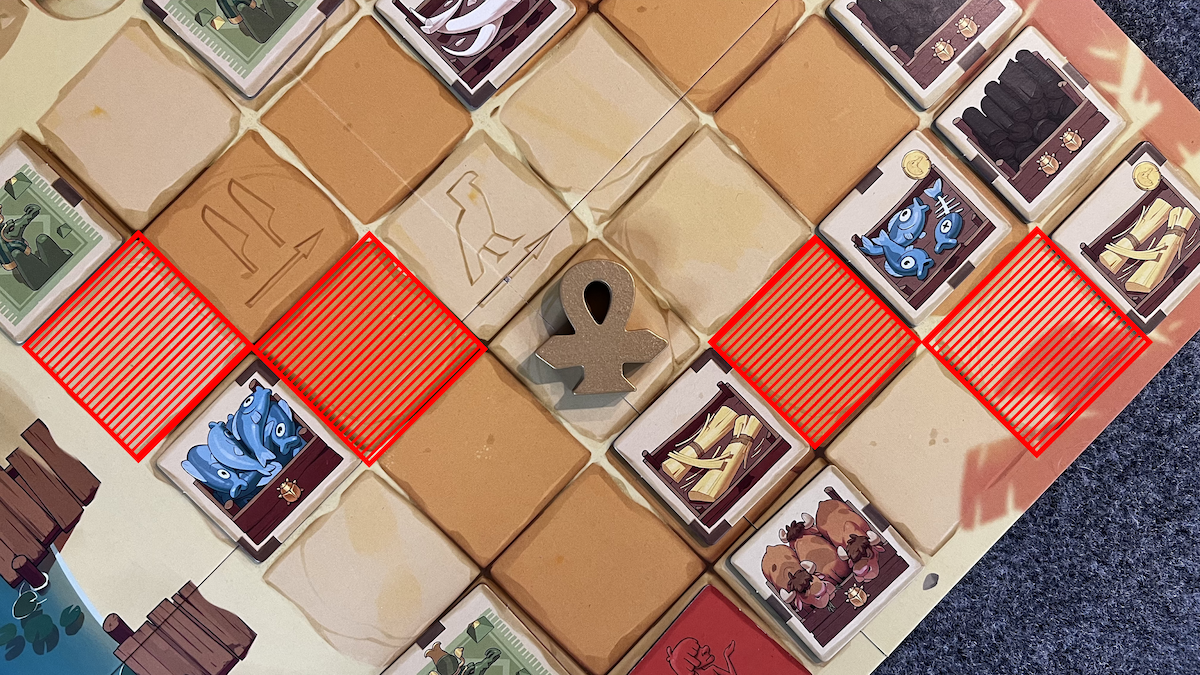
Game End
If there are no valid actions available, then end game scoring will begin immediately! Players must start by tallying up their Corruption, adding any remaining tiles in their hand to their Corruption Board. However, if you have a valid set in your hand but weren’t able to play it, those tiles will instead be discarded – they won’t score you points, but they won’t count against you either. The player with the least Corruption earns one Deben Token from the bag plus an extra token for every 3 less Corruption they have compared to their opponent. In the case of a tie, no Deben Tokens are awarded.
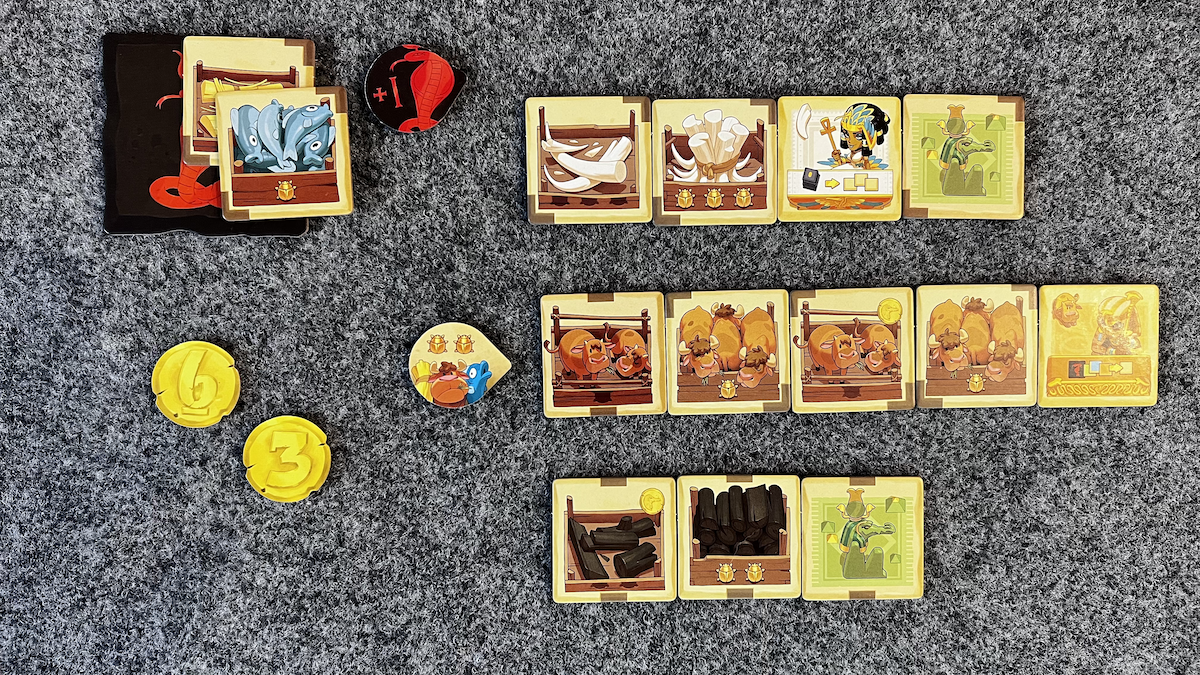
Once the bonus for least Corruption has been awarded, players will add up all the points from their scored sets (scarabs x number of tiles) and any Deben Tokens they’ve acquired and whoever has the most points wins! If there’s a tie, the player with the least Corruption wins, and if there’s still a tie, then according to the rulebook: “players will shake hands and immediately start a new game.” How exciting!
Sobek: 2 Players is GeekDad Approved!
Why You Should Play Sobek: 2 Players
At the time of this publication, I have played Sobek: 2 Players more than any other game in 2022 and although I will certainly attribute some of that to the ease of the online adaptation on Board Game Arena, I think it also speaks to the replayability of what I’ll confidently say is my favorite two-player game of the year. In fact, in my procrastination for this review, I’ve just gone and played a quick online game of Sobek: 2 Players to distract myself. The playtime? 9 minutes.
This is part of what I love about Sobek: 2 Players – even though the physical adaptation takes slightly longer with setup and upkeep, the game is an absolute blitz from start to finish, especially when you’re playing it with experienced players. I almost feel like the game should include a chess time clock to really up the difficulty! But even when teaching the game and playing for the first time, the setup, rules teach, and gameplay still leave you at a comfortable 30 minute runtime which is coveted in my household, especially with a toddler running around.
To me, Sobek: 2 Players hits that perfect sweet spot between tactical and strategic decision-making, where your choices are limited by the board state and your opponent’s actions, but you can affect those choices by the plans you made a few turns ago. Either way, everything is right in front of you and the more you play, you’ll start to realize the value of timing and of playing defense to prevent your opponent from stocking up on the perfect tiles.

From a strategy perspective, I also love that there’s no one surefire way to win this game. Sure, making a strong set of the Ivory tiles, which can give you a multiplier of 9, is certainly something to strive for. But this strategy can be easily thwarted if your opponent plays good defense, ends the game early, or even just gets lucky on tile draws. Because there’s so many external factors, your strategy has to be fluid, constantly changing based on the board state and your opponent’s sets. I love this attribute in a game because, in my opinion, that’s where the replayability lies and I think Sobek: 2 Players accomplishes this perfectly.

Now despite me enjoying this game thoroughly, the one knock I have against it is the theme. To me, this bustling Near Eastern marketplace theme is played out and it seems like a bit of an expected choice considering Pauchon’s history with his previous hit game Jaipur. In fact, I think the theme is really the only thing holding this game back from becoming the next two-player household staple ala Patchwork. The gameplay in my opinion is better than Patchwork – it’s just a pity that this pasted-on theme isn’t one that makes it jump off the shelf. Even still, I’ll be making the hard sell to anyone who wants to play this one with me, in spite of the theme, because of what Sobek: 2 Players brings to the table.
So if you’re looking for a new two-player game that plays in less than 30 minutes that’s simple to pick up but difficult to master, with great player interaction, endless replayability, and a sneaky depth of strategy, then might I suggest: Sobek: 2 Players?
For more information about Sobek: 2 Players, visit Pandasaurus Games’ website
Click here to see all our tabletop game reviews.
![]() To subscribe to GeekDad’s tabletop gaming coverage, please copy this link and add it to your RSS reader.
To subscribe to GeekDad’s tabletop gaming coverage, please copy this link and add it to your RSS reader.
Disclosure: GeekDad received a copy of this game for review purposes.






